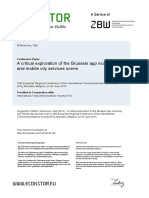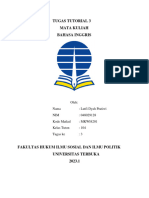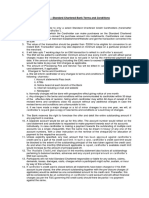SOS - Đoàn Nguyễn Gia Ân - Individual Assignment CCM201
SOS - Đoàn Nguyễn Gia Ân - Individual Assignment CCM201
Uploaded by
An DoanCopyright:
Available Formats
SOS - Đoàn Nguyễn Gia Ân - Individual Assignment CCM201
SOS - Đoàn Nguyễn Gia Ân - Individual Assignment CCM201
Uploaded by
An DoanCopyright
Available Formats
Share this document
Did you find this document useful?
Is this content inappropriate?
Copyright:
Available Formats
SOS - Đoàn Nguyễn Gia Ân - Individual Assignment CCM201
SOS - Đoàn Nguyễn Gia Ân - Individual Assignment CCM201
Uploaded by
An DoanCopyright:
Available Formats
An Gia Doan Nguyen – DS150166
Analysis of the Uber crisis case in 2017 and its Impacts on stakeholders
I. Introduction
In this day an age, traveling has become a crucial part and parcel of life. In March 2009,
the climbing demand for moving from one place to another resulted in the inception of
Uber - a technology ride-hailing platform, founded by Garrett Camp, Oscar Salazar &
Travis Kalanick (StartupTalky, 2022). Basically, it is essential to note that prior to Uber’s
entry, there were no technological advancements in the market. Thus, the Uber industry
brought about greater digital innovation in the transportation sector, especially the
traditional taxi industry since its first decade in business (Schneider, 2017). In 2015, Uber
announced the reach of 1 billion rides globally, marking its major milestone
(Fortune.com, 2015). After 2 years, Uber was honored with the title "Most Well-funded
Start-up" and the most valuable private company in the world as well, by CB Insights
(Forbes, 2017). Unfortunately, 2017 seems like a string of random controversies and
awards for Uber. To be clearer, at the same time, Uber confronted a series of problems
such as unfair treatment of employees, theft of technology from the prominent investor
Google, employee resignations, and loss of customers due to the campaign to
#DeleteUber and Travis Kalanick, the founder of Uber was caught arguing with a driver.
All these problems gave the company a bad reputation and criticism for three months
(January to March) despite CEO Travis Kalanick's resignation after his official public
apology. Lastly, faced with a series of scandals in all fields, Uber's slow and indecisive
response led to a 2017 crisis of unprecedented scale, affecting Uber's tangible and
intangible corporate value. This article focuses on analyzing some of Uber's typical
An Gia Doan Nguyen – DS150166
scandals in 2017 and their impact on the entrepreneur's stakeholders and relationships. In
addition, this exercise will also report the strategies implemented by Uber to tackle the
problems, maintain relationships with stakeholders, recover the company's position, and
discover how Uber returns to the ride-hailing market.
II. Body
Investigation of the Uber Case
Once thought to be one of the most successful startups in Silicon Valley, Uber in 2017
was running into a series of troubles. The trouble started in January 2017 with the
political side, Uber recently faced a backlash when Mr. Kalanick agreed to join President
Trump’s economic advisory council. About 500.000 customers deleted their accounts
after Uber lifted surge pricing during a strike triggered prompted widespread outrage via
a viral #DeleteUber campaign on social media (The Guardian, 2017). Right after
#DeleteUber 1 month, Waymo, a subsidiary of Google, sued Uber for allegations of
stealing trade secrets in self-driving car technology (Wired.com, 2017). Moreover, a few
days after the Waymo lawsuit, they had to open an internal investigation because the
former employee, Susan Fowler, published on Twitter Blog exposing discrimination and
sexual harassment alleged harassment. Weeks later, Kalanick was criticized for a video of
him arguing with an Uber driver over falling fares. However, Uber's media crisis spiral is
not over yet. In March, the investigation by the New York Times reported that Uber had
kickstarted “Greyball” a software feature to evade law enforcement officials since 2014
in several regions (The New York Times, 2017). The widespread frustration among Uber
customers reach its peak in November, Uber knowingly conceal a massive data breach in
An Gia Doan Nguyen – DS150166
2016 by paying $100,000 to hackers to delete 57 million users’ personal data worldwide
(Reuters, 2023). And all the while, they kept losing senior personnel. Prominent are
Director Jeff Jones the reason for not being culturally appropriate for management and
Rachel Whetstone – head of policy and communication.
Undoubtedly, Uber's crisis gives its competitors an edge. They emphasize safety, ethics,
and positive work environments, posing a challenge to Uber's market dominance. Despite
Uber's revenue continuing to develop, rival Lyft has been exploiting the difficulties of
Uber during its crisis stage. Uber's US market share fell from 82% in early 2017 to 70%
by Q4, coinciding with Lyft's 60% surge in users during the campaign #deleteUber
(Usatoday.com, 2017). Uber was fined $148 million for a data breach, the largest
settlement in the United States (The Washington Post, 2018). After the crisis, Uber faces
legal and regulatory challenges, damaging its reputation and finances. This has raised
questions about the possibility of an Uber IPO. Uber's value could plummet because of
recent reputational damages.
Analyzing Uber’s stakeholder relationship management
The Uber 2017 Crisis has significantly impacted both Uber and its relationships with
various stakeholder groups. Firstly, shareholders and stockholders are the first groups
directly affected by this crisis. The company's reputation has been tarnished, with an
estimated market capitalization of more than $70 billion down to a valuation of around
$50 billion (Somerville, 2017). Moreover, the share price of Uber's private stock fell
about 15% to a mid-to-high $30 amid a flood of bad news (The Information, 2017). Uber
An Gia Doan Nguyen – DS150166
shares that have not been IPO have been valued at 48.77 USD/share since the end of
2015. According to the Wall Street Journal, at the end of June 2017, 3 funds Vanguard
Group, Principal, and Hartford Funds priced Uber stock at $41.16 per share, valuing
shares down 15% (WSJ, 2017). After a year of scandal, Uber was forced to accept a
cheaper price in the deal. Uber shareholders on December 28, approved a 17.5% sale to a
group of investors, of which Softbank holds 15%, according to the Wall Street Journal.
After a series of crises, Uber’s market capitalization was at $48 billion, down 30 percent
from its June 2016 valuation of $68 billion, according to an Uber spokesperson
(Investing.com, 2017). The individual groups - Uber users, including Uber customers,
drivers, and employees - this is the group of stakeholders whose relationships were most
affected during this event. A series of assaults, rapes, and personal data leaks have
increased the insecurity of Uber users. Uber's response to the crisis is entirely
inappropriate, this destroys the level of customer trust that has decreased after Uber's
mass scandal, they turned to alternative solutions, leading to a shortage of market share
Uber. Current employees are also the group directly affected by the Uber crisis. They feel
depressed, trying to find a way out of this place, and want to prove that they are not toxic
factors in the organization.
How the firm tackles issues and their impacts
Uber's immediate public apology and swift actions to address the multi-faceted scandal
partly placated negative attention. In May 2018, the company announced that it would
take a series of actions to show its responsibility and decisiveness such as increasing
An Gia Doan Nguyen – DS150166
driver screening, checking criminal background every year, or not issuing provisions to
prevent people from driving. In June 2017, Travis Kalanick, co-founder and former CEO,
resigned along with many apology letters to Uber users and employees. Appointing Dara
Khosrowshahi as the new CEO, Uber's Crisis Management Strategy Offers Lessons for
CEOs (chiefexecutive.net) transforms leadership, initiating comprehensive reforms in
corporate culture to promote an ethical work environment thought. Through mass media
channels, Uber has publicly acknowledged the challenges that need to be overcome and is
ready to take full responsibility for the affected parties. Uber's apology ad, new CEO
Dara Khosrowshahi speaks directly to the viewer showing straightforward expectations
of doing the right thing. Its response rate of 14% disapproves of Uber's apology, while
32% are undecided about whether to forgive Uber and 31% forgave Uber (Business
Insider, 2018). After multiple scandals and controversies, financial health is likely a good
measurement for Uber's brand. Ride-hailing company's full-year net loss widened to $4.5
billion in 2017 during its tumultuous year. For 2017 Uber’s booking rate was $45 billion,
which rose 136% from $19 billion in 2016. But then small increasing by 10% to just $50
billion in 2018. Those proportions say Uber’s slowing growth as its scale.
Although its revenue and narrowed losses increased, the deceleration of growth from
over 100% to 40% (2017 – 2018) is considerable. Negative publicity and reputational
damage have resulted in reduced user demand and sluggish Uber's revenue growth in the
recent years. While the company continues to issue statements regarding each incident,
it's hard to ignore the fact that mistakes continue to pile up. Uber's biggest failure in
dealing with the public interest is the lack of transparency. A series of crises in 2017 put
An Gia Doan Nguyen – DS150166
Uber in the dilemma of a public company. 2 years after that crisis, Uber is valued at $55
billion, 40% less than its peak projected price before going public. 2019, as The
Washington Post, reported Uber's reputation hasn't changed much since #DeleteUber in
2017. Compared to the last crisis in August 2022 reported by (The Guardian, May 2022)
(More than 124,000 confidential documents leaked out, exposing attempts to aid Uber
political lobbying, texts reveal company used ‘kill switch’ during raids to stop police
from accessing the data and the case former Uber CEO told executives ‘Violence
guarantees success’), it shows that the effort to improve Uber's image after the crisis
contains many potential drawbacks on a company's ability to win back their market — no
matter how much they spend.
III. Conclusion
The series of Uber's trouble in 2017, suffered a litany of negative headlines that would
have arguably dinged — from corporate culture and work environment to certainty in
regulatory and legal enforcement, a lawsuit about patent, shedding executives and
employees continuously. It has caused great financial damage as well as the reputation of
Uber. Through this crisis, it can be seen that Uber almost failed to manage the crisis
successfully because it did not lay out the necessary framework to identify the type of
crisis it faced, allowing them to identify and then implement the appropriate strategies to
deal with the crisis. Furthermore, Uber does not have a backup plan, so even if they
consider the actual options available, they cannot implement them effectively because
they do not have the background or guidance in the form of a contingency plan for better
An Gia Doan Nguyen – DS150166
response. Facing successive crises in finance, corporate culture, and ethics .. Uber
completely fell into a passive position, which should have been handled with a proactive
and effective crisis management strategy. Today, Uber is still facing the most
fundamental shortcomings of its crisis management and management strategy. The
importance of this case is the lesson learned for every newborn tech company to not leave
out their crisis management behind in their business operation.
References
1. NASDAQ, 2023, Uber Technologies, Inc. Common Stock (UBER) Stock Price,
Quote, News & History | Nasdaq, Retrieved from: https://www.nasdaq.com/market-
activity/stocks/uber
2. Faiz Siddiqui, 2019, Uber has a reputation problem - The Washington Post, Retrieved
from https://www.washingtonpost.com/technology/2019/08/29/even-after-ubers-ipo-
long-shadow-deleteuber-still-looms/
3. Hern, A. 2018, Uber fined £385,000 for data breach affecting millions of passengers,
The Guardian, Retrieved from
https://www.theguardian.com/technology/2018/nov/27/uber-fined-385000-for-data-
breach-affecting-millions-of-passengers-hacked
4. Court of Justice of the European Union , 2017, The service provided by Uber
connecting individuals with non-professional drivers is covered by services in the
field of transport (europa.eu), Retrieved from
https://curia.europa.eu/jcms/upload/docs/application/pdf/2017-12/cp170136en.pdf
5. The Economist, 2017, Uber is facing the biggest crisis in its short history
An Gia Doan Nguyen – DS150166
6. Retrieved from https://www.economist.com/business/2017/03/25/uber-is-facing-the-
biggest-crisis-in-its-short-history
7. Bernstein Crisis Management.com, 2017, Crisis Management Analysis: Uber’s Road
Ahead, Retrieved from https://www.bernsteincrisismanagement.com/crisis-
management-analysis-ubers-road-ahead/
8. Berkeley.edu, 2017, #DeleteUber Social Movement on social media - #MoveMe
(berkeley.edu), Retrieved from https://moveme.berkeley.edu/project/deleteuber/
9. Los Angeles Times, 2017, Uber lost $4.5 billion in 2017, but its revenue jumped - Los
Angeles Times (latimes.com), Retrieved from
https://www.latimes.com/business/technology/la-fi-uber-earnings-20180214-
story.html
10. Savannah Dowling, Alex Wilhelm, Natasha Mascarenhas, Jason D. Rowley, 2019,
Inside The Uber S-1: Revenue, Growth, And Losses (crunchbase.com), Retrieved
from https://news.crunchbase.com/venture/inside-the-uber-s-1-revenue-growth-and-
losses/
11. Anita Balakrishnan, 2017, Scandals may have knocked $10 billion off Uber's value:
Report (cnbc.com), Retrieved from https://www.cnbc.com/2017/04/25/uber-stock-
price-drops-amid-sexism-investigation-greyballing-and-apple-run-in--the-
information.html
12. Afred Lee, 2017, Controversies Take a Toll on Uber’s Stock — The Information,
Retrieved from https://www.theinformation.com/articles/controversies-take-a-toll-on-
ubers-stock
An Gia Doan Nguyen – DS150166
13. The New York Times, 2017, Uber Investigating Sexual Harassment Claims by Ex-
Employee, The New York Times (nytimes.com), Retrieved from
https://www.nytimes.com/2017/02/19/business/uber-sexual-harassment-
investigation.html
14. Susan Fowler, 2017, Personal Blog: Reflecting on one very, very strange year at Uber
— Susan Fowler (susanjfowler.com), Retrieved from
https://www.susanjfowler.com/blog/2017/2/19/reflecting-on-one-very-strange-year-
at-uber
15. Aaron Drapkin, 2023, Data Breaches That Have Happened in 2023 So Far - Updated
List (tech.co), Retrieved from https://tech.co/news/data-breaches-updated-list
16. Reuters, 2017, Uber says 2016 data breach hit 2.7 million UK users, or most of its
base, Retrieved from https://www.reuters.com/article/us-uber-cyberattack-uk-
idUSKBN1DT1YP
17. Eric Newcomer, 2017, In Video, Uber CEO Argues With Driver Over Falling Fares -
Bloomberg, Retrieved from
https://www.bloomberg.com/news/articles/2017-02-28/in-video-uber-ceo-argues-
with-driver-over-falling-fares#xj4y7vzkg
18. United States Court of Appeals, Federal Circuit, 2017 Case Law: WAYMO LLC v.
Uber Technologies, Inc., 870 F. 3d 1350 - Court of Appeals, Federal Circuit 2017 -
Google Scholar, Retrieved from https://scholar.google.com/scholar_case?
case=2080796736390250641&q=uber+waymo&hl=en&as_sdt=2006
An Gia Doan Nguyen – DS150166
19. Mike Issac, 2017, How Uber Deceives the Authorities Worldwide, Retrieved from
https://www.nytimes.com/2017/03/03/technology/uber-greyball-program-evade-
authorities.html
20. Mansoor Iqbal, 2023, Uber Revenue and Usage Statistics (2023) - Business of Apps,
Retrieved from https://www.businessofapps.com/data/uber-statistics/
21. Bill Murphy, 2017, In Just 60 Seconds, London Made #Uber the World's Top
Trending Hashtag. Here's What Happened | Inc.com, Retrieved from
https://www.inc.com/bill-murphy-jr/in-just-60-seconds-london-made-uber-worlds-
top-trending-hashtag-heres-what-happened.html
An Gia Doan Nguyen – DS150166
An Gia Doan Nguyen – DS150166
You might also like
- Noon E-Commerce Company Economics Final PojectDocument51 pagesNoon E-Commerce Company Economics Final PojectMohamed SherifNo ratings yet
- Arbitrage Betting Cheat SheetDocument8 pagesArbitrage Betting Cheat Sheetkomupadia6772No ratings yet
- Developing Skills For Business LeadershipDocument8 pagesDeveloping Skills For Business Leadershipsyeda maryemNo ratings yet
- Process ValidationDocument16 pagesProcess ValidationMaruti Sapatale100% (1)
- Analysis of The Indian Smart Kitchen Appliances Market, Forecast To FY2026Document126 pagesAnalysis of The Indian Smart Kitchen Appliances Market, Forecast To FY2026Andrew Bacon100% (1)
- UKF Payment Markets Summary 2022Document10 pagesUKF Payment Markets Summary 2022vetemNo ratings yet
- AASHTO R 50-09 Geosynthetic Reinforcement PDFDocument4 pagesAASHTO R 50-09 Geosynthetic Reinforcement PDFankit100% (1)
- UberDocument7 pagesUberxoloho9054100% (1)
- Navigation Update User Guide: Business Team 2 Hyundai Mnsoft DEC, 2020Document89 pagesNavigation Update User Guide: Business Team 2 Hyundai Mnsoft DEC, 2020bakchoNo ratings yet
- Zoomcar SlideshareDocument101 pagesZoomcar SlidesharevishalNo ratings yet
- Merritt Morning Market 3812 - Mar 31Document2 pagesMerritt Morning Market 3812 - Mar 31Kim LeclairNo ratings yet
- Digital Malaysia Report 2013Document124 pagesDigital Malaysia Report 2013Web Pod100% (1)
- FMS Delhi - Summer Placement Report 2022Document9 pagesFMS Delhi - Summer Placement Report 2022Ishant GuptaNo ratings yet
- Deliveroo Rider AppDocument13 pagesDeliveroo Rider AppDando Silly-willy DindoNo ratings yet
- Xerox Is A Fantastic Example of Brand PositioningDocument4 pagesXerox Is A Fantastic Example of Brand PositioningNgoc TranquangNo ratings yet
- Analysis of Consumer Behavior Towards Share Trading and Sales Promotion of Anand Rathi Securities LTD - Ambala"Document48 pagesAnalysis of Consumer Behavior Towards Share Trading and Sales Promotion of Anand Rathi Securities LTD - Ambala"amar12345678No ratings yet
- BykeaDocument10 pagesBykeaMaria SiddiquiNo ratings yet
- Food DeliveryDocument41 pagesFood DeliveryJuan GarciaNo ratings yet
- P6 M3 Unit 8Document18 pagesP6 M3 Unit 8Cameron Sammakieh100% (1)
- MRAA-Assignment 2Document23 pagesMRAA-Assignment 2NAMAN AGARWALNo ratings yet
- 11 - Comviva - Live Projects PDFDocument4 pages11 - Comviva - Live Projects PDFRaj PatelNo ratings yet
- SummaryDocument5 pagesSummarysmall mochiNo ratings yet
- Notes From The Ai Frontier: Applying Ai For Social GoodDocument52 pagesNotes From The Ai Frontier: Applying Ai For Social GoodHimanshu Aditya BhattNo ratings yet
- Banks Ratio AnalysisDocument22 pagesBanks Ratio AnalysisKiran PoudelNo ratings yet
- Q3 FinalDocument28 pagesQ3 FinalmarketingNo ratings yet
- The Curious Digital Marketer 2.0Document27 pagesThe Curious Digital Marketer 2.0komal0% (1)
- GreytHR Product WalkthroughDocument24 pagesGreytHR Product WalkthroughSairam IndlaNo ratings yet
- Investor Presentation: November 2020Document33 pagesInvestor Presentation: November 2020howardschipper3878No ratings yet
- Executive Summery: Study On Consumer BehaviourDocument67 pagesExecutive Summery: Study On Consumer BehaviourAvyan SinghNo ratings yet
- PitchBook Vertical DescriptionsDocument9 pagesPitchBook Vertical DescriptionsSaid EsparzaNo ratings yet
- HR Induction BBK FinalDocument39 pagesHR Induction BBK FinalPramod Kumar SinghNo ratings yet
- Hafsa ProposalDocument3 pagesHafsa ProposalHafsa SweetNo ratings yet
- Genisys Corporate PDFDocument13 pagesGenisys Corporate PDFarunkumar277041No ratings yet
- UberDocument12 pagesUberThảo LinhNo ratings yet
- Analysis of Adex Size and Trend in MalaysiaDocument29 pagesAnalysis of Adex Size and Trend in Malaysiakumar2875No ratings yet
- Fund Performance MetlifeDocument11 pagesFund Performance MetlifeDeepak DharmarajNo ratings yet
- Sbi INTOUCHDocument10 pagesSbi INTOUCHPragati BhartiNo ratings yet
- SHIFT Inc Company Profile 2021Document16 pagesSHIFT Inc Company Profile 2021Account nameNo ratings yet
- Travelers Respond To A Personalized Experience On Mobile and Email With 5x Increase in BookingsDocument4 pagesTravelers Respond To A Personalized Experience On Mobile and Email With 5x Increase in BookingsAdarsh SrivastavaNo ratings yet
- E Commerece, e BankingDocument8 pagesE Commerece, e BankingAman GuptaNo ratings yet
- 10-RFP For Desktop Support and Related ServicesDocument21 pages10-RFP For Desktop Support and Related ServicesVarun BatraNo ratings yet
- 1976BTPinNovinWyrkaBray PDFDocument22 pages1976BTPinNovinWyrkaBray PDFGRACELIA AYU EVANYNo ratings yet
- Anil Kewlani Bba AfsDocument70 pagesAnil Kewlani Bba AfsVinit raksheNo ratings yet
- Leoni Annual Report 2020Document221 pagesLeoni Annual Report 2020Ph Ghadeer MajedNo ratings yet
- Olam Internationa1Document1 pageOlam Internationa1skumah48No ratings yet
- Group 5 - Dove No Digital Distortion CampaignDocument16 pagesGroup 5 - Dove No Digital Distortion CampaignPhuong Trinh LeNo ratings yet
- Organised Versus Unorganised Retail in IndiaDocument11 pagesOrganised Versus Unorganised Retail in IndiaSharma Sumant0% (1)
- Marketing Segmentation Targeting and Positioning PF AirTelDocument11 pagesMarketing Segmentation Targeting and Positioning PF AirTelAkanksha GuptaNo ratings yet
- A Critical Exploration of The Brussels App Economy and Mobile City Services SceneDocument16 pagesA Critical Exploration of The Brussels App Economy and Mobile City Services SceneNelsonNo ratings yet
- Takeda ARDocument152 pagesTakeda ARaswin_nNo ratings yet
- Kumari BankDocument26 pagesKumari BankSheetal KarmacharyaNo ratings yet
- Fact 2013 PDFDocument56 pagesFact 2013 PDFOrganic NutsNo ratings yet
- CRM System at Oyo Rooms: Section B - Group 1Document23 pagesCRM System at Oyo Rooms: Section B - Group 1RahulSamaddarNo ratings yet
- Flipkart Till Date: A Case Study Prabhjot KaurDocument6 pagesFlipkart Till Date: A Case Study Prabhjot KaurAyaz RazaNo ratings yet
- Resume ChaitanyaDocument1 pageResume ChaitanyaChaitanyaNo ratings yet
- The Review Unmanned Surface Vehicle Path Planning: Based On Multi-Modality ConstraintDocument41 pagesThe Review Unmanned Surface Vehicle Path Planning: Based On Multi-Modality Constraintمجتبی فرامرزیNo ratings yet
- Project Report AkkiDocument33 pagesProject Report AkkiaakashNo ratings yet
- DR - Dirisinapu Lakshmi Sreenivasa Reddy: Page 1 of 2 M-8828804Document2 pagesDR - Dirisinapu Lakshmi Sreenivasa Reddy: Page 1 of 2 M-8828804manisatyamNo ratings yet
- Chapter-7. Peer ReviewDocument16 pagesChapter-7. Peer ReviewAARCHI JAIN100% (1)
- JIO QuestionnaireDocument12 pagesJIO QuestionnaireAMAN KUMAR PASS12NM4073/2019No ratings yet
- FIN 401 Final Report BodyDocument9 pagesFIN 401 Final Report Body1711........100% (1)
- Activity 1: Entrepreneurship Scavenger Hunt: You and The Person YouDocument3 pagesActivity 1: Entrepreneurship Scavenger Hunt: You and The Person YouRosemarie R. ReyesNo ratings yet
- Uber and Its Expansion Strategy in ChinaDocument6 pagesUber and Its Expansion Strategy in ChinaLê ThảoNo ratings yet
- Ethics AssignmentDocument4 pagesEthics AssignmentSanjana DeotaleNo ratings yet
- Smart Grid Sensors - Improving Reliability For Distribution Grids During Energy Transition and Grid ModernizationDocument12 pagesSmart Grid Sensors - Improving Reliability For Distribution Grids During Energy Transition and Grid ModernizationSabri GünaydınNo ratings yet
- Tugas 3 ISBDDocument5 pagesTugas 3 ISBDlutfii dyahNo ratings yet
- Deffered AnnuityDocument23 pagesDeffered AnnuityBryanHarold BrooNo ratings yet
- Beer Game Group 15Document23 pagesBeer Game Group 15강철희No ratings yet
- MATHS QUEST HSC Mathematics General 2 (4th Edition)Document448 pagesMATHS QUEST HSC Mathematics General 2 (4th Edition)JIESHUN (JASON) WANG73% (11)
- Low-Cost Housing Policies and Squatters Struggles in Nigeria - The Nigerian Perspective On Possible SolutionsDocument11 pagesLow-Cost Housing Policies and Squatters Struggles in Nigeria - The Nigerian Perspective On Possible SolutionssatgasppksNo ratings yet
- Complaint - 9.10.24Document133 pagesComplaint - 9.10.24robert.garciaNo ratings yet
- Bip 2154-2008Document50 pagesBip 2154-2008ali rabieeNo ratings yet
- Social Environment: Macro Environment of Momo (M - Service) 1Document3 pagesSocial Environment: Macro Environment of Momo (M - Service) 1Lê Gia KhoaNo ratings yet
- 19A SCM Inventory WNDocument28 pages19A SCM Inventory WNmohamed.ashour1400No ratings yet
- Tax System - Essay, Elena CucciattiDocument6 pagesTax System - Essay, Elena CucciattiElena CucciattiNo ratings yet
- Risk and Return Final.Document43 pagesRisk and Return Final.MD RakibulNo ratings yet
- Sustainable Packaging DissertationDocument6 pagesSustainable Packaging DissertationCollegePaperHelpCanada100% (1)
- Internal Audit Checklist SampleDocument25 pagesInternal Audit Checklist SampleLimNo ratings yet
- Cash Management and Working Capital ProblemsDocument2 pagesCash Management and Working Capital ProblemsRachel RiveraNo ratings yet
- Entrep Q1 Week6Document3 pagesEntrep Q1 Week6Naj CumlaNo ratings yet
- Accounting (Share Capital)Document11 pagesAccounting (Share Capital)PowerPoint GoNo ratings yet
- Graphic Anatomy Atelier Bow WowDocument140 pagesGraphic Anatomy Atelier Bow WowMirjana PasajlicNo ratings yet
- PAS 24 - RELATED PARTY DISCLOSURES LectureDocument12 pagesPAS 24 - RELATED PARTY DISCLOSURES LectureMon Ram100% (1)
- Lect 7 MortgageDocument24 pagesLect 7 MortgageRANDAN SADIQNo ratings yet
- International Business Environment Analysis On Titan Watch IndustryDocument41 pagesInternational Business Environment Analysis On Titan Watch IndustryPragya DhakarNo ratings yet
- Microsoft Teams Partner Opportunity PresentationDocument17 pagesMicrosoft Teams Partner Opportunity PresentationAshraf NoorNo ratings yet
- Course: English For Academic Writing Course Code: ELC550 Test: Annotated Bibliography Time: 2 HoursDocument7 pagesCourse: English For Academic Writing Course Code: ELC550 Test: Annotated Bibliography Time: 2 HoursKHAIRUL NADIAHNo ratings yet
- Management Accounting:: A Road of Discovery A Road of DiscoveryDocument45 pagesManagement Accounting:: A Road of Discovery A Road of DiscoveryMelat TNo ratings yet
- MBA 2022-23 Community Development Project ReportDocument16 pagesMBA 2022-23 Community Development Project ReportMohd SajidNo ratings yet
- SCB EMI Terms and ConditionsDocument2 pagesSCB EMI Terms and ConditionsSanam PandeyNo ratings yet

























































































